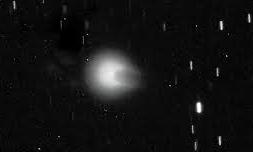
Devil Comet approaching Earth could burst in space today
text_fieldsA comet nicknamed the "Devil Comet" due to its horn-like eruptions is drawing closer to Earth, releasing bursts of ice and gas at regular 15-day intervals.
These eruptions occur as the comet's sun-facing side aligns with solar heat, a predictable event tied to its 2-week rotation. Astronomers are captivated by this clockwork-like cosmic phenomenon.
Experts noted that the last series of eruptions have followed a precise 15-day cycle, and the anticipation is building for another event around December 29–30. Nick James from the British Astronomical Association highlighted the regularity of these outbursts, suggesting the possibility of another imminent occurrence.
Dubbed as 12P, this celestial body is described as a cryovolcano or a cold comet.
It undergoes eruptions caused by the accumulation of gas and ice, which ultimately combusts akin to frozen cans of Coke. This explosive process forces icy material, originating from cracks in the comet's crust, out into space. The comet's core measures 18.6 miles in diameter, equivalent to the size of a small city.
Richard Miles, another astronomer from the British Astronomical Association, likened the comet's eruptive nature to a cosmic version of the 'Old Faithful' geyser, triggered specifically by sunrise at its position.
Comet 12P/Pons-Brooks is renowned for exhibiting volcanic-like behaviour. Unlike typical volcanoes that spew molten rock, cryovolcanic comets eject a combination of gases and ice.
As Comet 12P/Pons-Brooks approaches the sun, its temperature rises, causing pressure to build within its nucleus. This heightened pressure leads to periodic eruptions expelling nitrogen and carbon monoxide along with icy particles through fissures in its surface.
These eruptions are known for producing distinct visual shapes when observed through telescopes, with formations resembling devil horns, horseshoes, or even likened to the Millennium Falcon from Star Wars.
















